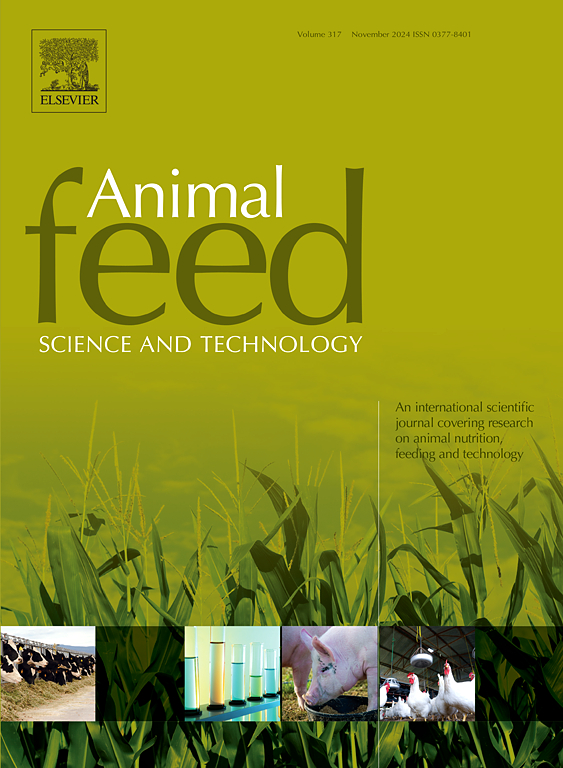Dietary inclusion of microalgae meal for Pacific white shrimp (Litopenaeus vannamei): Effects on growth performance, flesh quality, and immunity
IF 2.5
2区 农林科学
Q1 AGRICULTURE, DAIRY & ANIMAL SCIENCE
引用次数: 0
Abstract
Microalgae have emerged as a promising supplement or feed additive and ensure sustainability standards in aquaculture. The present study aimed to investigate the effects of dietary marine microalgae, Phaeodactylum tricornutum and Tetraselmis sp., supplementation on growth performance, feed intake, tissue morphology, biochemical characteristics of some tissues and expression of immune related genes in hepatopancreas of Pacific white shrimp, Litopenaeus vannamei. L. vannamei (about 0.8 g) was fed six isonitrogenous and isolipidic diets including six dietary marine microalgae (P. tricornutum: Tetraselmis sp. = 1: 1) content 0 (CON), 1.5 % (MA-1.5 %), 3 % (MA-3 %), 4.5 % (MA-4.5 %), 6 % (MA-6 %) and 7.5 % (MA-7.5 %) for 9 weeks. Subsequently, the shrimp was challenged with Vibrio parahaemolyticus injection. Microalgae supplementation could increase the survival rate of from 78.33 % to 100 % and decrease the feed conversion ratio from 1.66 to 1.37. Additionally, microalgae significantly decreased the crude lipid and increased the content of n-3 PUFA in the muscle (P > 0.05). The intestinal villi in MA-4.5 % had the greatest height and maintained the most intact shape. Following 8 h of V. parahaemolyticus stress, the mortality rate of shrimp in MA-3 % group was 1/6 that in CON group. Furthermore, the MDA content in hepatopancreas was significantly lower in the MA-3 % group compared to the CON group (P > 0.05). Gene expression analysis revealed significant upregulation of antibacteria-related genes (alf1, alf2, crus, lyz, pen3a and pen4), proPO system-related genes (sp, pexn, propo1 and propo2), and antioxidant gene cat in the hepatopancreas of shrimp from the MA-3 % group (P > 0.05). In conclusion, the findings from this study indicate that the microalgal mixture is an effective dietary additive for L. vannamei, promoting improved growth performance, enhanced flesh quality, and stronger immunity.
凡纳滨对虾饲料中添加微藻粉:对其生长性能、肉质和免疫力的影响
微藻已成为一种很有前途的饲料添加剂,并确保了水产养殖的可持续性标准。本试验旨在研究饲粮中添加海洋微藻、三角褐指藻和四足藻对凡纳滨对虾(Litopenaeus vannamei)肝胰腺生长性能、采食量、组织形态、部分组织生化特性及免疫相关基因表达的影响。l .对虾(约0.8克)美联储6 isonitrogenous和isolipidic饮食包括六个饮食海洋微藻(p . tricornutum: Tetraselmis sp。= 1:1)内容0”(体质)、“1.5 % (ma - 1.5 %),3 % (MA-3 %),4.5 % (ma - 4.5 %),6 % (MA-6 %)和7.5 % (ma - 7.5 %)9周。随后,对虾注射副溶血性弧菌。添加微藻可使成活率从78.33 %提高到100% %,饲料系数从1.66降低到1.37。微藻显著降低了肌肉中粗脂肪含量,显著提高了n-3 PUFA含量(P >; 0.05)。MA-4.5 %的肠绒毛高度最高,形状保持最完整。在8 h的副溶血性弧菌胁迫下,MA-3 %组对虾的死亡率是CON组的1/6。MA-3 %组肝胰腺MDA含量显著低于CON组(P >; 0.05)。基因表达分析显示,MA-3 %组对虾肝胰腺中抗菌相关基因(alf1、alf2、crus、lyz、pen3a和pen4)、proPO系统相关基因(sp、penn、propo1和propo2)和抗氧化基因cat均显著上调(P >; 0.05)。综上所述,本试验结果表明,微藻混合物是一种有效的凡纳滨乳杆菌饲料添加剂,可改善其生长性能,改善肉质,增强其免疫力。
本文章由计算机程序翻译,如有差异,请以英文原文为准。
求助全文
约1分钟内获得全文
求助全文
来源期刊

Animal Feed Science and Technology
农林科学-奶制品与动物科学
CiteScore
6.00
自引率
6.20%
发文量
266
审稿时长
3 months
期刊介绍:
Animal Feed Science and Technology is a unique journal publishing scientific papers of international interest focusing on animal feeds and their feeding.
Papers describing research on feed for ruminants and non-ruminants, including poultry, horses, companion animals and aquatic animals, are welcome.
The journal covers the following areas:
Nutritive value of feeds (e.g., assessment, improvement)
Methods of conserving and processing feeds that affect their nutritional value
Agronomic and climatic factors influencing the nutritive value of feeds
Utilization of feeds and the improvement of such
Metabolic, production, reproduction and health responses, as well as potential environmental impacts, of diet inputs and feed technologies (e.g., feeds, feed additives, feed components, mycotoxins)
Mathematical models relating directly to animal-feed interactions
Analytical and experimental methods for feed evaluation
Environmental impacts of feed technologies in animal production.
 求助内容:
求助内容: 应助结果提醒方式:
应助结果提醒方式:


